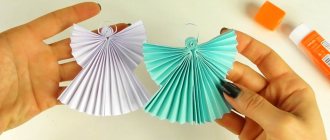The need for a candle solely as a source of light is a thing of the past. Today, no one will read or sew in a dimly lit room, and power cuts to save money are no longer practiced. The product is useful only in a force majeure situation. In the modern world, candles have become relevant again, but now as decoration. The stores offer an amazing variety of products and they are not that cheap. But it is not at all necessary to buy finished products. It’s much more interesting to create unique candles with your own hands.
Advantages and disadvantages of making candles yourself
Making a candle yourself is quite possible. Consumables are freely available, and the recipes and technology are simple and clear. The imagination of the masters reveals more and more new facets of this art. The variety of homemade interior candles is off the charts - shaped, scented, gel. Candles are a popular element of serving on wedding and New Year's tables. To create your own high-class works, study the technology of their production. By making candles with your own hands, you realize your own ideas, choose the desired shape, color, decor, and saturate them with your favorite aroma. The acquired skills will help you become a sought-after craftsman in the production of unique candles. This business can eventually develop into a profitable business. The benefits of creating products at home are plentiful.
Disadvantages of this activity - if you are going to do this professionally:
- the presence of many competitors;
- the need to find customers for sales.
Candle base - what material to choose
A variety of materials are used to make candles - wax, paraffin, stearin and even gel. Each has its own advantages and disadvantages.
wax
Lovers of all things natural can treat themselves to the opportunity to create their own candles from beeswax. Its pleasant aroma outshines the odors of any artificial flavors. Foundation is a product secreted by bees through special glands. The inhabitants of the hives use it to build their honeycombs. The substance has known hardness and excellent bactericidal properties.
It is represented by a wide palette of colors - from white with a slight yellowish tint to dark yellow and even brown.
Heating to 35°C is enough to make the material plastic, but to melt it you need to raise the temperature to 62-68°C. Wax candles are light, attractive and fragrant. Products harden much faster than paraffin analogues. This is a natural and therefore expensive product. Its cost is 4 times higher than that of paraffin.
Use unnecessary containers to melt the wax, because it is extremely difficult to get rid of.
Gel
The gel is a transparent material. This environmentally friendly substance does not emit toxic substances. It contains natural ingredients - glycerin, gelatin, tannin.
Transparent gel candles look more impressive than their paraffin and wax “brothers”. They do not drip as the substance evaporates from the candlestick. The empty container can be refilled with gel or used for another purpose. The service life of such products is several times longer than traditional options.
If your imagination has no limits, making gel candles will help unleash your potential. Such products look simply magical thanks to the transparent material, which reveals exquisite decor. Gel candles will be a wonderful gift for friends, relatives and colleagues.
Wax
Benefits of wax:
- pleasant aroma;
- bright burning;
- ability to secrete phytoncides;
- environmental friendliness.
Wax candles are made by repeatedly dipping a wick into melted material. If you add it to the “company” of paraffin and stearin, you can get very beautiful long-burning products.
Paraffin
The most commonly used material. It is one of the most inexpensive options. Paraffin is sold by weight or in the form of finished products. Both options are suitable for home production. Candles or paraffin briquettes need to be cut into small pieces. You can simplify your task and purchase ready-made masses for making candles with various fillers, flavors and dyes. They are somewhat more expensive than simple paraffin, but they allow you to save on the purchase of special additives.
Paraffin, when burned, releases a certain amount of harmful substances into the air, so you should not leave the candle burning for a long time.
Ingredients
For production you will need materials:
- Wax, paraffin or foundation.
- Thread for making a wick.
- Container for melting wax, paraffin or foundation.
- Forms for filling.
- Wick holder.
Types of wax
There are 3 types of wax suitable for making candles:
- Palm.
- Bee.
- Soy.
Palm wax melts at temperatures above 60 degrees; upon cooling, crystallization occurs and a beautiful velvet pattern is formed on it. If you take a solid form with special patterns, they will be covered with a pleasant fringe.
Beeswax is the most popular because it not only creates a pleasant smell, but is also beneficial for the human body.
Soy wax is made from beans, which makes it environmentally friendly and does not create soot when burned.
Wick
The wick can be purchased at any available craft store. You can make it yourself, but the process is very labor-intensive. Important! Candle wicks should be made only from natural materials, preferably cotton.
You not only need to choose the right material, but also the size. For candles with a diameter over 8 centimeters, the wick must consist of at least 22 threads. This is provided so that a small wick does not quickly burn out, or a large wick does not quickly melt a small candle.
For stability, it can be wrapped with thin wire, which will create stability and a reinforced effect.
After making the wick or purchasing it, you need to soak it in molten paraffin. To change the color of the flame during combustion, it must be treated with special solutions.
Forms for filling
There are a large number of forms for filling, let’s look at the main ones:
- Made from soft plastic. This mold is intended for making small candles.
- Made of metal. In such forms, the candles are perfectly even and smooth, and the metal can withstand high temperatures.
- Made from silicone. These forms are also resistant to high temperatures, but wear out quickly.
- Made from plaster. The advantage of plaster is that a person can make any shape according to his imagination.
Melting containers
To melt wax or any other material, you can use a regular tin can. The melting procedure is carried out as follows:
- Water is poured into the pan and brought to a boil.
- The container is lowered into the pan and paraffin is placed in it.
It is worth remembering the precautions when melting wax:
- This should not be done over an open fire, as the wax may catch fire. This also applies to microwave ovens.
- When melting wax, you need to stir it regularly.
Aroma oils
To improve the smell of a candle, you can add aromatic oils or medicinal herbs to it. This will not only help you enjoy the pleasant smell and improve your health.
Required Tools
To make candles at home you will need:
- material for the base - wax, paraffin, stearin, soy wax are suitable;
- “battery” of forms;
- wick;
- wick holders;
- a plate for carefully moving appliqué fragments onto the wax base;
- a metal knife for cutting large pieces of wax or paraffin;
- grater for grinding materials;
- two different-sized pans for setting up a water bath. It is advisable that the small pan have a spout;
- thermometer;
- stove - gas or electric;
- flavorings;
- varied decor;
- stirring stick;
- toothpicks;
- dyes - you can also use wax crayons, crushed with a grater, aniline paints or actor's makeup;
- stacks.
It is not advisable to add aromatic oils to wax. The candles will smoke and the smell will be completely different from what was intended. There are a variety of specialty candle scents available on the market.
Wick
The wick can be:
- a braid knitted from threads;
- twisted cord;
- jute twine.
The main condition when choosing is to take into account the material of the future candle. For a wax product, a loose braided cord made of cotton thread is suitable, which will not smoke. For other options, a dense wick is required. Ideally, you need to purchase twine from a specialized store. You can immediately buy several products of different thicknesses.
Manufacturers offer many types and sizes of cords. Keep in mind that if the wick is too thick, the flame will burn too hot and the candle will burn out faster than expected. Excessively thin laces will burn out before the candle and the fire will go out. The wider the bottom of the candle, the thicker the wick should be.
To select the correct cord thickness, pay attention to the markings:
- No. 1 – for candles with a diameter of up to 3 cm;
- No. 2 – from 3 to 5 cm;
- No. 3 – from 5 to 6 cm;
- No. 4 – from 6 cm.
Before pouring the melted candle mass into the mold, you need to immerse the tip of the wick in the mixture. This way it will burn better. To secure it in shape, pass it through the hole in the bottom and secure with tape. If there is no such hole, use a round metal holder or stick it to the bottom with a drop of wax. The free end of the cord is wound around a pencil and pulled so that the wick is located in the center of the candle. After hardening, it is necessary to cut off the excess part of the cord - when burning, a sample that is too long will smoke.
If you decide to use old candles as a base, you can use their original wick.
Form
To make candles, special molds are required. At the initial stage, you can use any empty containers. A cotton swab container, a tin can or a yogurt cup can be your first molds.
Types of forms for making candles:
- Polycarbonate - transparent, very convenient containers. They are not particularly durable and after a while they begin to crack and leak.
- Made of plastic - stronger than polycarbonate analogues. These products are a little cheaper, but they are opaque and this is not very convenient. Some models may be equipped with a stopper at the base of the container. This makes it easier to remove the finished candle.
- Made of soft, thin plastic - suitable for making miniature candles. If there is no hole in the bottom, you can pierce it using a hot knitting needle.
- Made of metal - aluminum, steel. Strong and durable containers with perfectly smooth walls, which allows you to get beautiful candles. The metal mold filled with molten wax gets very hot, so be careful.
- Made of silicone - detachable or drop-down products. You can use molds for baking and making ice. A hole is pierced in the bottom, but over time the hole begins to rupture. As a result, the paraffin is poured out. You can temporarily solve this problem using masking tape.
You can make original silicone molds with your own hands.
Additional tools and accessories
When making candles, additional materials and tools occupy an important place - stacks, spatulas, measuring cups, dyes, flavors, wick holders, thermometers, which simplify the process.
Fragrances – give candles a pleasant smell and improve the atmosphere in the room. The air is purified and it becomes easier to breathe. But the sources of fragrances are different and not everyone will suit you.
There are several types of flavors:
- Special - they are a liquid substance, sold along with other materials for the production of candles. For 1 kg of wax you can use no more than 30 ml of the composition;
- aromatic oils are synthetic products not intended for candle making. If you do decide to use them, do not add more than 10-15 drops per 500 grams of wax;
- natural flavors – finely ground cinnamon, lemon zest, crushed dried herbs. Some of them may not dissolve well in the molten material, preventing the wax from hardening or the wick from burning. For 450 grams of base, 1 tablespoon of powder will be enough.
- essential oils – from natural herbs and flowers. Each of the oils has special specific properties. Not all of them are guaranteed to be suitable for making candles, so it's worth testing each new ingredient. For 450 grams of wax you will need no more than 10-15 drops.
Thermometer – necessary to measure the temperature of the candle mass. At the time of pouring into molds, it should be within 68-72ºС. Otherwise, the candle may end up with a frosty effect and a rough surface. Sometimes they deliberately achieve an “aged” effect using cooled paraffin. If the mixture is too hot, it may saturate the wick and leak out of the mold through the hole in the bottom. Thermometers are conventional and electronic.
Preparing the workplace and tools
Not everyone has the opportunity to allocate a separate room for a workshop. It is advisable that the workplace is located in a room with running water and ventilation. It must maintain a constant temperature and exclude drafts. In a city apartment, a kitchen is suitable. It is necessary to think about each stage of the work, correctly place materials and tools - dishes, molds, wicks, accessories, paper napkins. You will need space to grind, filter and pour the wax into containers.
You need a spacious and stable table with a horizontal top. The surface will have to be covered with something. Wrapping paper, an old waterproof tablecloth, towels, and newspapers are suitable. The floor should also be covered with an old rug or sheet of linoleum. You can use sheets of corrugated cardboard. Provide storage space for molds, utensils, tools, essential oils, dyes and other necessary components. You will need plywood for grinding wax, a stand for a hot container. You need a device on which you will melt the wax. You can use a regular stove and equip a water bath, slow cooker or rice cooker with the ability to control the temperature.
How to melt wax correctly
To speed up the process, chop the material using a knife or grater. Fill a smaller pan with wax and place it in a larger container of water. For small dishes, you can use containers made of heat-resistant glass, stainless steel, enameled or aluminum pans. Do not use cast iron or copper as they will detract from the color of the wax. Cleaning wax from utensils is incredibly difficult, so forget about using it for cooking.
Place several stones or a special silicone gasket on the bottom of a large pan. This will prevent the dishes from contacting each other and the wax will not overheat. Place the water bath on low heat and stir the contents constantly. The melted wax should have a uniform structure - without lumps. Check the temperature - it should not be higher than 68-72ºС.
Installation and fastening of the filter
It is best to use wax that has undergone primary cleansing from propolis particles and debris. If you have unrefined material, you need to melt it and strain through a metal sieve. But this procedure is often not enough, so it is necessary to filter the wax again. This will get rid of any unwanted particles that may be in the molten material. Pass the substance through a nylon cloth secured to the container with a rubber band or a special paint filter.
Adding aromatic oils and paint
To color paraffin, place pieces of wax crayons or a special dye in a melting container. You can pour paraffin of different colors in layers or combine different pencils and get bright rainbow stains.
If you want to enjoy a scented candle, add your favorite essential oil to the melted wax. These substances have different properties. The scent of lavender oil is calming and relaxing. Lemon and rosemary help you take your mind off bad thoughts. The combination of orange and cloves improves your mood, and the aroma of cedar and lemon relieves stress.
Pouring wax and decorating the finished candle
After installing the wick, it is necessary to fix the lower edge of the cord. To do this, pour a little melted wax onto the bottom of the mold. If necessary, adjust the position of the wick and wait a minute for the material to set. Pour the remaining wax into the mold. Be careful - the melted mixture can seriously burn you. Within a day, the hardened candle can be removed from the mold and proceed to its further design.
Trim the wick, leaving the tip long enough for easy lighting. Use a new candle no sooner than 24 hours after it has completely hardened.
Decorating is a fascinating process. Suitable decorations include lace, jute twine, gift paper, beaded threads, ribbons, artificial flowers, dry sprigs of herbs and wildflowers, and citrus slices. If you like spicy scents, use coffee or cinnamon in your candle design.
Decorate kitchen products with cereals or seeds. The simplest option is to place a candle in a transparent candlestick or a jar of larger diameter and fill the space between it and the walls with peas, millet, and colored rice. Another way is to paste the grains over the walls of the product, which is very easy to do with a hand-held hair dryer. Warm up the surface and press the grains into the softened wax.
Stylish and sophisticated products, decorated with natural materials, are ideal for the bathroom or living room. Surrounded by pebbles, shells, pine cones and dried branches, candles will look very impressive.
DIY wax candle and candle wick: step-by-step master class
To make a candle you will need:
- wax or paraffin (household candles are suitable);
- cotton thread or floss;
- water bath pan;
- container for melting wax;
- molds for candles (tin, glass or plastic);
- wooden sticks for attaching wicks (1 candle mold = 1 stick).
Advice! If this is your first time deciding to make a candle with your own hands, ask someone close to you to help you. The wax hardens within 15 minutes, so you need to act quickly.
Step 1
Place a cotton thread in the center of each candle mold. Secure the upper edge of the thread to a wooden stick.
Instead of a wooden stick, you can use a pencil
Step 2
Place a container of wax (paraffin) in a water bath. To speed up the melting process, it can be cut into small pieces or grated. Melt the wax over low heat, stirring constantly. The finished consistency should be uniform, without lumps or pieces of paraffin.
Wax will melt faster if you break it into small pieces.
Step 3
Pour some melted wax into the bottom of the mold. This will fix the bottom edge of the wick in the right place. If necessary, adjust its position. Wait about a minute for the wax to thicken and the wick to set before moving on to the next step.
While the wax is soft, you can adjust the position of the wick
Step 4
Fill the mold with the remaining melted wax.
Work carefully: melted wax is very hot
Step 5
A day later, after the candle has completely cooled and hardened, trim off the excess edge of the wick.
Leave the wick long enough to light easily.
It is recommended to use the finished candle no less than 24 hours after it has completely hardened.
Note! The cooled candle does not have to be left in the jar - after making it, it can be removed from the mold. Before starting work, select a container for filling with a straight, even edge that is not narrowed at the top. You can also use plastic cups, ice cube trays, or homemade tetra pack templates.
Making a new candle from old ones
If you want to make your first candle in your life, don’t rush to go to the store for the necessary components. First, check the contents of your drawers - perhaps there are a few old cinders lying around in the far corner. They fully deserve you to give them a second life. The remains of candles can be melted down and created a new - aesthetic and functional product.
Step-by-step instruction:
- Prepare unnecessary candles. If you don't have any suitable material in your home, buy the cheapest products in the store.
- Grind them with a grater or knife.
- Build a water bath and place the crushed material in the top vessel.
- Melt the paraffin until there are no pieces left. You need to constantly stir the mixture and prevent it from overheating.
- Attach a wick to the bottom of the mold.
- Pour the liquid substance into the prepared form and wait until it hardens.
- We take the candle out of the mold and decorate it.
Uneven spots on the bottom of the candle can be removed using a hair dryer.
Making gel candles at home
Gel candles have gained popularity due to their attractive appearance and ability to burn for a long time. The production uses the same melting technology as when creating wax or paraffin products. Do not allow the gel to overheat - it may become cloudy.
Stir the mixture carefully to prevent the formation of bubbles. After this, the gel is poured into glass or plastic molds. Candles in glasses look very beautiful. The main difference between this material is that it is completely transparent. You can place pebbles, sparkles, beads, glass balls, dried flowers, pieces of fruit or candied fruits inside the candle.
If you fill the container with decor before pouring the gel, the elements will be distributed along the bottom of the candle. Another way is to add decorations to an already filled mold so that they float or remain on the surface. This way you can distribute the decor over the entire area according to your idea. To ensure that the composition created inside the candle is clearly visible, you should choose transparent forms. The gel can be made colored and fragrant.
Before pouring the gel into molds, slightly heat the transparent containers. This will prevent the formation of bubbles.
How to make colored candles with colored fire with your own hands?
We wrote earlier about how to make colored wax. By the way, an interesting option is a multi-layered multi-colored candle. The main thing in this matter is to be slow, because each previous layer must dry before the next one is formed.
IMPORTANT: Such a product must cool for at least 5 hours.
Colored multilayer candles Plain colored candle
The secret of the colored flame lies in the combustion of salts . Moreover, the composition of the salts depends on what shade you want to get:
- Yellow, orange – table salt
- Red – strontium nitrate or sodium chloride
- Blue – copper chloride
- Green – barium chloride
- Violet – potassium chloride
Such candles are good because they are non-toxic , and if they leak occasionally, they will leave practically no traces . However, they take a long time to flare up .
Candles with colored flames
How to make a paraffin candle
You can purchase paraffin bars or simply buy the cheapest candles in the store. Lubricate the mold for casting products with Vaseline or oil to make it easier to remove the hardened candle. Or place the filled container in the freezer so that when it thaws, the contents simply slide out.
Manufacturing stages:
- We turn paraffin into shavings.
- Melt the material in a water bath.
- We fix the wick in the mold - the thread should be taut with a stick and located in the center.
- Pour the mixture into the mold in one go so that the surface of the future candle is smooth. If dye is added to the composition, you need to stir the liquid when pouring it into the mold.
- Leave the candles in the same room to harden.
If after hardening there is empty space around the wick, heat a small amount of the mixture in a water bath and fill the hole.
Beautiful do-it-yourself carved candles: shapes
Carved candles seem incredibly complicated to make, but some of them are simple to make. Prepare:
- Paraffin
- Form of your choice. It's better to start with something simple like the outline of an egg. As for the material, due to the ease of removing the impression, it is recommended to choose silicone
- Wick or weave of cotton threads
- Containers into which colored paraffin will be poured. Cans, saucepans or even tin cans that are unnecessary in everyday life will do.
- Special dyes or wax crayons
- Hook and crossbar for it
IMPORTANT: Select the size of the hook taking into account the fact that it should be comfortable for you to hold it in your hands.
- Bucket with water
- Paper napkins are those that are soft to the touch.
- Knife
A silicone mold for making candles may look like this
. Just like in previous master classes, melt the paraffin in a water bath. Pour it into the mold , leaving a long – at least 10 cm – wick.
After the cast is removed , you should hang it on a hook using a long wick .
Hanging a candle blank
Heat the paraffin with the addition of shades in a water bath
IMPORTANT: Bringing it to 60-80 degrees will be quite enough. At the same time, you need to stir, because the paraffin settles.
This is approximately what containers with colored paraffin for candles should look like.
Start lowering the blank suspended on a hook into the container with the colors you need. Try to do it quickly, but at the same time smoothly. Allow the paraffin to drain, and then to fix the remaining paraffin, lower the product into a bucket of water. There can be several dozen layers, because hot paraffin gives a very thin layer.
This is what applying layers to a future candle looks like
Let's assume that these were the inner layers. Now carefully dip the workpiece one by one into the desired shades to obtain a gradient effect. If splashes occur, carefully remove them with a napkin.
Forming a gradient at the candle blank
Now hang the workpiece on the hook - and cut out patterns ! First, cut off the excess layers of paraffin that have formed smudges. For convenience, you can make a sketch , since there will be no opportunity to make edits.
IMPORTANT: On average, paraffin cools down in 10 minutes, so try to cut out patterns during this time.
Drawing a sketch on the candle blank
Next, cut out the patterns as your imagination dictates. You can even twist the cut strip and put it into the cutout - it will create an interesting effect.
Carving a pattern in a candle
Twisting the cut-out candle strip
Inserting a twisted strip into the candle cutout
Flowers are formed in a similar way - certain patterns are cut out and folded in the right way. You can decorate a candle , for example, with beads.
Forming a flower in a candle
This is how a beautiful carved candle turns out
Of course, there can be a huge number of options for shapes and colors
Graceful curls of a carved candle
Another option for beautiful curls on carved candles Carved candle with a marine theme
Carved candle with birds
How to properly color and decorate a candle
Coloring candle mass is very easy. You need to add pieces of special candle dyes to the melted material. They are available in a huge variety of shades.
The color saturation of hot candle mass is always greater than that of cooled wax. Therefore, even if the composition seems bright enough to you, it is better to add a little more dye.
Sometimes it is not possible to quickly find the required shade. Use available materials! Wax crayons are the best alternative to real paint.
You should not paint candles with gouache and other paints - they do not dissolve well and settle to the bottom of the mold. Cosmetics are also not suitable - eye shadow, blush, lipstick, as well as soap dyes, food colors and instant coffee.
A variety of materials are used to decorate candles - fabric, lace, burlap, satin ribbons, flower petals. Carved candles look great. You can use the decoupage technique - there are suitable napkins for any occasion. An interesting idea is to wrap a candle with a family photo or an image of you and your loved one.










